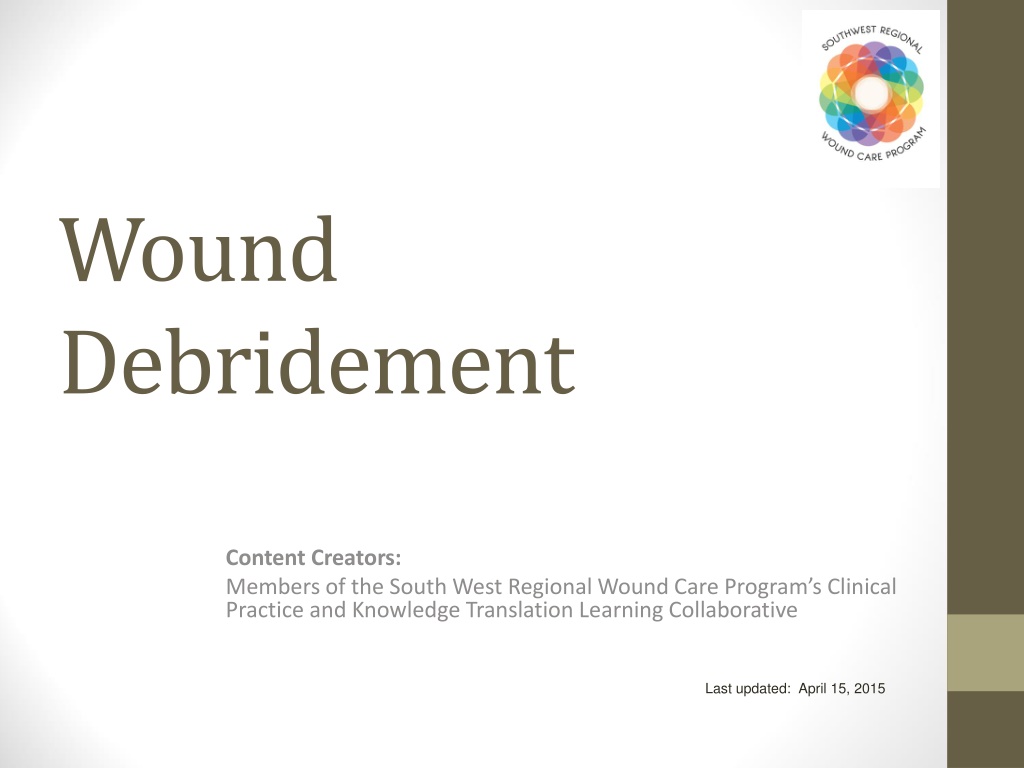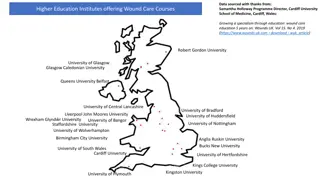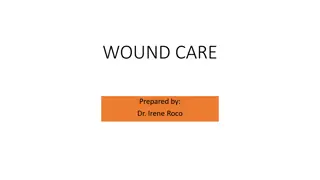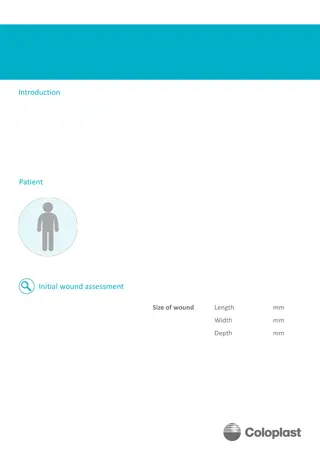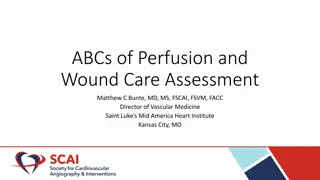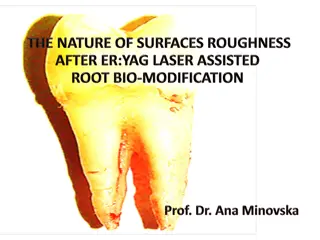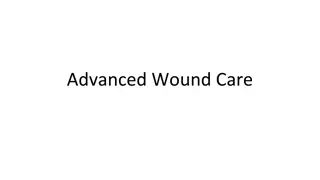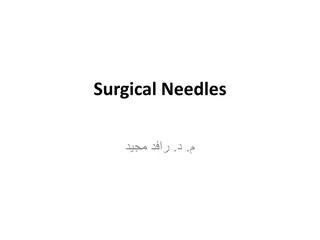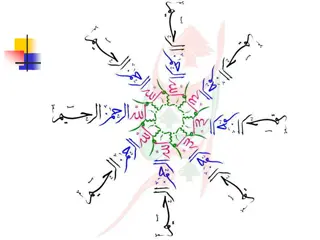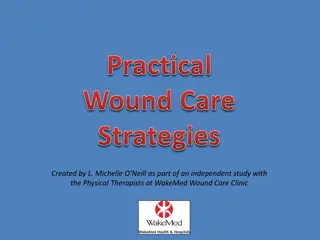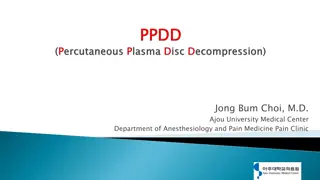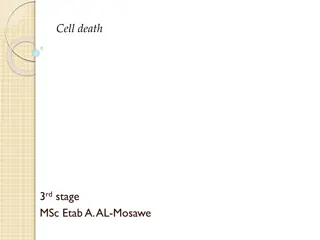Understanding Necrotic Tissue and Debridement in Wound Care
Explore the significance of necrotic tissue in impairing wound healing and learn about various therapeutic interventions for debridement, including mechanical, enzymatic, sharp, autolytic, and biologic methods. Discover how necrotic tissue color and consistency can indicate the severity of a wound, affecting healing outcomes and infection risks.
Download Presentation

Please find below an Image/Link to download the presentation.
The content on the website is provided AS IS for your information and personal use only. It may not be sold, licensed, or shared on other websites without obtaining consent from the author. Download presentation by click this link. If you encounter any issues during the download, it is possible that the publisher has removed the file from their server.
E N D
Presentation Transcript
Wound Debridement Content Creators: Members of the South West Regional Wound Care Program s Clinical Practice and Knowledge Translation Learning Collaborative Last updated: April 15, 2015
Learning Objectives 1. Develop an understanding of the significance of necrotic tissue 2. Review therapeutic interventions for necrotic tissue including: 1. Mechanical debridement 2. Enzymatic debridement 3. Sharp debridement 4. Autolytic debridement 5. Biologic Debridement South West Regional Wound Care Program 2 3. Review the outcome measurements of debridement and referral criteria
Photographs and Illustrations Images/illustrations obtained via Google Images South West Regional Wound Care Program 3
South West Regional Wound Care Program SIGNIFICANCE OF NECROTIC TISSUE 4
Necrotic Tissue1-4 Necrotic tissue impairs wound healing as it is a physical barrier to: Granulation tissue formation Wound contraction Re-epithelialization South West Regional Wound Care Program Necrotic tissue may also harbor bacteria, which could lead to wound infection, thus impairing wound healing The more necrotic tissue there is in a wound, the1, 5: More severe the damage is Longer it will take the close the wound 5
Necrotic Tissue1 As tissues die they change in: Color South West Regional Wound Care Program Consistency Adherence 6 http://www.google.com/intl/en_ALL/images/logos/images_logo_sm.gif
Necrotic Tissue: Color1 As the depth/severity of the wound increases, the color of the necrotic tissue changes: White/gray Tan/yellow Brown/black South West Regional Wound Care Program 7 Yellow Black http://www.google.com/intl/en_ALL/images/logos/images_logo_sm.gif White/Gray
Necrotic Tissue: Consistency1 As the tissues dry out, the consistency of the necrotic tissue changes: Mucinious Soft, stringy Soft, soggy Hard South West Regional Wound Care Program Soft, soggy Hard Mucinious 8 Soft, stringy http://www.google.com/intl/en_ALL/images/logos/images_logo_sm.gif
Consistency Continued Consistency of necrotic tissue is related to its moisture content and refers to its cohesiveness1 Consistency also varies as tissue damage worsens/deepens1,5-6: Slough: yellow/tan, thin, mucinious or stringy partial thickness damage Eschar: brown/black, soft of hard full-thickness damage South West Regional Wound Care Program 9
Necrotic Tissue: Adherence1 Adhesiveness of the debris to the wound bed and the ease with which the two are separated Necrotic tissue tends to be more adherent: The deeper or more severe the damage is The less moist the wound is South West Regional Wound Care Program 10 http://www.google.com/intl/en_ALL/images/logos/images_logo_sm.gif
Summary of Necrotic Tissue Characteristics Worsening Tissue Damage Color Consistency Adherence White/gray Mucinous Clumps South West Regional Wound Care Program Yellow fibrinous Soft, stringy Loosely attached Yellow/tan (slough) Black/brown (eschar) Soft, soggy Attached at the base only Firmly adherent to base and edges Hard 11
Types of Necrotic Tissue Predominant types of necrotic tissue include: Slough Fibrin Eschar Gangrene Hyperkeratosis South West Regional Wound Care Program 12
Description of Necrosis Types Slough Fibrin Eschar Gangrene Hyperkeratosis Mucinious Soft, stringy Soft, soggy Mucinious Soft, stringy Soft, soggy Soft, soggy Hard Hard Soft, soggy Hard White/yellow White/yellow Black/brown Black/brown White/gray South West Regional Wound Care Program Clumps Loosely attached Attached at base Clumps Loosely attached Attached at base Attached at base Firmly attached Firmly attached Firmly attached 25-100% covered 25-100% covered 50-100% covered 50-100% covered Surrounds wound edges 13 http://www.google.com/intl/en_ALL/images/logos/images_logo_sm.gif
Type of Necrosis By Wound Etiology Arterial/ischemic wounds: Dry gangrene Thick, dry, desiccated black/gray appearance Firmly adherent May be surrounded by an erythematous halo South West Regional Wound Care Program Neurotropic wounds: Do not present with necrotic tissue in wound typically Have hyperkeratosis surrounding wound Venous leg ulcers: Eschar or slough Usually yellow fibrous material 14 Pressure Sores: Relates to the depth of the injury http://www.google.com/intl/en_ALL/images/logos/images_logo_sm.gif
South West Regional Wound Care Program DEBRIDEMENT: INTERVENTION FOR NECROTIC TISSUE 15
What is Debridement? The process of removing dead, contaminated, or adherent tissue and/or foreign material from a wound Five primary methods: Mechanical Debridement Enzymatic Debridement Sharp Debridement Autolytic Debridement Biologic Debridement South West Regional Wound Care Program 16 http://www.google.com/intl/en_ALL/images/logos/images_logo_sm.gif
Mechanical Debridement1 The use of some outside force to remove dead tissue , i.e.: Wet to dry gauze dressings Wound irrigation Whirlpool South West Regional Wound Care Program Wet to dry gauze continues to be the most commonly used debridement technique despite it s multiple disadvantages 17 Click on the picture of the Versajet for a video of jet lavage http://www.google.com/intl/en_ALL/images/logos/images_logo_sm.gif
Mechanical Debridement Continued1 Advantages: Familiar to health care providers Wound irrigation can reduce bacterial burden Whirlpool may soften necrotic debris South West Regional Wound Care Program Disadvantages (wet-to-dry gauze): Non-selective Rarely applied correctly Painful More costly (labor and supplies) May cause maceration Releases airborne organisms and causes cross-contamination9 18
Enzymatic Debridement1 Applying a concentrated, commercially prepared (proteolytic) enzyme to the surface of the necrotic tissue, in the expectation that it will aggressively degrade necrosis by digesting devitalized tissue South West Regional Wound Care Program Requires a physician order and must be used according to the manufacturers instructions Cannot be used on dry wounds any eschar present must be cross hatched 19 http://www.google.com/intl/en_ALL/images/logos/images_logo_sm.gif
Enzymatic Debridement Continued1 Advantages: Selective Effective in combination with other debridement techniques Disadvantages: Enzymatic use is prolonged more than necessary, increasing costs Can be slow 3-30 days to achieve a completely clean wound bed (it is faster than autolysis however) Requires a specific pH range (may cause local irritation due to pH changes) May be inactivated by contact with heavy metals (zinc or silver) Risk of maceration and infection Requires frequent dressing changes (1-3 times per day) South West Regional Wound Care Program 20
Sharp Debridement1 Performed either one time (surgical) or sequentially (conservative) Surgical sharp debridement: Use of scalpel, scissors, or other sharp instruments Removal of viable and non-viable tissue Most rapid and effective May convert chronic wound into an acute wound Requires analgesics and availability of cautery equipment Indicated for removal of thick, adherent and/or large amounts of non-viable tissue and when advancing cellulitis or signs of sepsis are present Requires a certain level of expertise, education and skill Risk of bleeding South West Regional Wound Care Program 21 Click here for a video of surgical debridement
Sharp Debridement Continued1 Conservative sharp wound debridement (CSWD): Use of scalpel, scissors, or other sharp instruments Rapid and effective Used in combination with enzymatic, mechanical, and/or autolytic debridement to speed the removal of non-viable necrotic debris/tissue Can be performed in any health-care setting by non-physician clinicians (if they have the knowledge, skill, judgment and authority to do so) Does not require transfer to an acute facility South West Regional Wound Care Program 22 http://www.google.com/intl/en_ALL/images/logos/images_logo_sm.gif
Autolytic Debridement1 The process of using the body s own mechanisms (enzymes) to remove nonviable tissue The collection of fluid at the wound site, promotes rehydration of the dead tissue and allows enzymes within the wound to digest necrotic tissue South West Regional Wound Care Program May be accomplished by the use of any moisture-retentive dressings, i.e. hydrocolloids, hydrogels, hypertonic dressings/gels, and/or transparent films 23 http://www.google.com/intl/en_ALL/images/logos/images_logo_sm.gif
Autolytic Debridement Continued1 Advantages: Painless in the majority of people with wounds Effective, versatile, and easy to perform Selective Low cost Can be used in conjunction with other debridement techniques South West Regional Wound Care Program Disadvantages: Slow Caregiver education required for compliance 24 http://www.google.com/intl/en_ALL/images/logos/images_logo_sm.gif
Biologic Debridement1 A.k.a. larval/maggot debridement therapy (use of medical grade green bottle fly larvae/maggots) Controlled application of disinfected maggots to the wound to remove the nonviable tissue 10 Regulated by the FDA as a prescription only medical device South West Regional Wound Care Program Maggots are left in the wound for 2-3 days . They secrete proteolytic enzymes that break down necrotic tissue and then ingest the liquefied tissue 10 25 The secretions also have antimicrobial properties, promote growth of human fibroblasts and improve granulation tissue formation11-12
Biologic Debridement Continued1 Widely used in parts of Europe and South America Advantages: Reduces bacterial burden Growth-stimulating effects Selective South West Regional Wound Care Program Click on the maggots to see a short video on this therapy Disadvantages: Limited number of studies Yuck factor Availability of sterile medical grade maggots Lack of policies and procedures Picture1.png 26 http://www.google.com/intl/en_ALL/images/logos/images_logo_sm.gif
Review of Types of Debridement Debridement Type Definition Examples Wet-to-dry gauze, wound irrigation, whirlpool, pulsed lavage Use of an outside force to remove non-viable tissue Mechanical South West Regional Wound Care Program Application of a concentrated, commercially prepared enzyme to digest non-viable tissue Enzymatic Collagenase Use of sharp instruments to remove non- viable tissue Sharp Scalpel, scissor, curette use Use of the body s own enzymes in wound fluid along with moisture retentive dressings to degrade non-viable tissue Use of hydrocolloids, films, hydrogels, and/or hypertonic dressings Autolytic 27 Application of medical grade maggots to remove non-viable tissue Larval debridement therapy Biologic*
Why Debride? To remove the physical barrier to epidermal resurfacing, contraction, or granulation To reduce bacteria burden by removing necrotic tissue South West Regional Wound Care Program To convert a chronic wound to an acute wound by stimulating the healing cascade To facilitate earlier coverage of the wound with active dressings or biologicals 28
Who Can Debride? Under the 1991 Regulated Health Professions Act (Ontario), debridement is within the controlled acts authorized for nursing South West Regional Wound An RN or an RN(EC) who meets certain conditions, i.e. has the knowledge, skill, judgment and authority, can initiate and/or provide an order for an RN or RPN to perform care of wound below the dermis or mucous membrane, which includes cleansing, soaking, irrigating, probing, debriding, packing, dressing8 Care Program 29
Who Can Debride: CSWD The Long Term Care Homes Act and the Public Hospitals Act do not allow a nurse to initiate CSWD in the absence of a physician order South West Regional Wound There is no Act that precludes nurses in the community from performing CSWD in the absence of a physician order, but it is STRONGLY suggested that the nurse communicates her intent to perform CSWD to the primary care physician BEFORE doing so Care Program 30 http://www.google.com/intl/en_ALL/images/logos/images_logo_sm.gif
Who Can Debride Continued Specialized practice skills such as CSWD are not generally included in the RN s basic preparation; therefore additional instruction and supervision are necessary to ensure the individual is competent to perform the identified skills or acts South West Regional Wound Care Program 31 http://www.google.com/intl/en_ALL/images/logos/images_logo_sm.gif
Who Can Debride Continued The nurse who performs CSWD is expected to have: A good knowledge of relevant anatomy The ability to identify viable tissue Access to adequate equipment, lighting and assistance The capacity to explain the procedure and obtain informed consent The ability to manage pain and discomfort prior to, during, and following the procedure The skill to deal with complications such as bleeding The ability to recognize their skill limitations and those of the technique Knowledge of infection control practices The ability to utilize secondary debridement techniques if needed South West Regional Wound Care Program 32
How Do We Debride? After a thorough holistic assessment of the person and their wound, and determination that debridement is indicated, you must first choose the most appropriate type(s) of debridement. This is dependent on the: Knowledge, skill and authority of the health care practitioner Availability of required resources Overall condition of the person with the wound, and their healability Characteristics of the wound and wound tissue Presence of wound related pain Required speed and tissue selectivity of debridement Costs associated with available debridement techniques Presence of wound infection Physical environment South West Regional Wound Care Program 33 http://www.google.com/intl/en_ALL/images/logos/images_logo_sm.gif
Choosing How to Debride7 South West Regional Wound Care Program 34 Canadian Association of Wound Care
Red/Yellow/Black System The type of non-viable tissue present can help identify the phase of wound healing and as such, the most appropriate debridement options13: Wound bed is clean and wound tissue is red/pink Goal: maintain moist wound healing environment Wound bed has slough/fibrin present and tissue may be a combo of red/pink + ivory/canary yellow/green (depending if infection is present) Not all yellow is bad granulation grows through yellow fibrin. Healthy tendon may appear white/yellow Goal: maintain moist wound healing environment whilst managing excessive exudates and removing slough via sharp, mechanical, enzymatic, and/or autolytic debridement Wound bed has non-viable tissue present. Tissue combo may be dark brown/ grey/ black +/- red/pink +/- ivory/canary yellow/green. Goal (healable wound and eschar is not stable and on heel): remove non-viable tissue via sharp, mechanical, enzymatic and/or autolytic debridement Red South West Regional Wound Care Program Yellow* Black* 35 *If more than one color of tissue is present in the wound bed, target treatment based on the tissue type that is present in the greatest amount
South West Regional Wound Care Program OUTCOME MEASUREMENTS OF DEBRIDEMENT AND REFERRAL CRITERIA 36
Outcome Measures1 Three appropriate characteristics for evaluating the effectiveness of debridement are the: Type of necrotic tissue South West Regional Wound Care Program Amount of necrotic tissue Adherence of the necrotic tissue to the wound 37
Amount of Necrotic Tissue1 Amount should diminish progressively if therapy appropriately Can be measured: Using linear measurements (length x width) By determining percentage of wound bed covered By photography South West Regional Wound Care Program Estimate percentages in the following way: <25% wound bed covered 25-50% wound covered >50 and <75% wound covered 75-100% wound covered 38
Type of Necrotic Tissue1 Type of necrotic tissue should change as the wound improves, when conservative methods of debridement are used As necrotic tissue rehydrates its appearance will change from dry/black, to soggy/soft/yellow, to mucinous easily dislodged tissue South West Regional Wound Care Program Can rate the type of necrotic tissue as: White/gray nonviable tissue and/or non-adherent yellow slough Loosely adherent yellow slough Adherent soft black eschar Firmly adherent, hard black eschar 39
Adherence of Necrotic Tissue1 Adherence of necrotic tissue should decrease as debridement proceeds Necrotic tissue may initially be firmly attached, then starts lifting (usually at edges first), and eventually disengages from the base of the wound South West Regional Wound Care Program 40 http://www.google.com/intl/en_ALL/images/logos/images_logo_sm.gif
Referral Criteria1 Dry gangrene or dry ischemic wounds Elevated temperature No wound improvement Evidence of cellulitis or gross infection Exposed bone or tendon Evidence of abscess South West Regional Wound Care Program 41 http://www.google.com/intl/en_ALL/images/logos/images_logo_sm.gif
SWRWCP Debridement Resources South West Regional Wound Care Program 42
Review 1. The significance of necrotic tissue 2. Therapeutic interventions for necrotic tissue including: 1. Mechanical debridement 2. Enzymatic debridement 3. Sharp debridement 4. Autolytic debridement 5. Biologic Debridement South West Regional Wound Care Program 3. Outcome measurements of debridement and referral criteria 43
South West Regional Wound Care Program http://www.google.ca/intl/en_ALL/images/logos/images_logo_sm.gif 44 For more information visit: swrwoundcareprogram.ca
References 1. Bates-Jensen BM, Apeles NCR. Management of necrotic tissue. In: Sussman C, Bates-Jensen B., eds. Wound Care: A collaborative practice manual for health professionals. Third Ed. Baltimore: Lippincott Williams & Wilkins, 1997:197-214. Alterescu V, Alterescu K. Etiology and treatment of pressure ulcers. Decubitus. 1988;1:28-35. Winter G. Epidermal regeneration studied in the domestic pig. In: Hung TK, Dunphy JE, eds. Fundamentals of Wound Management. New York: Appleton-Century-Crofts; 1979:71-111. Sapico FL, Ginunas VJ, Thornhill-Hoynes M, et al. Quantitative microbiology of pressure sores in different stages of healing. Diagn Biol Infect Dis. 1986;5:31-38. Shea D. Pressure sores: Classification and management. Clin Orthop. 1975:112:89-100. Witkowski JA, Parish LC. Histopathology of the decubitus ulcer. J Am Acad Dermatol. 1982;6:1014- 1021. Sibbald RG, Williamson D, Orsted HL, et al. Preparing the wound bed: Debridement, bacterial balance and moisture balance. Ostomy/Wound Management. 2000;46(11):14-35. College of Nurses of Ontario. Decisions about procedures and authority. Pub. No. 41071. Toronto. Last retrieved October 21, 2014 from: http://www.cno.org/Global/docs/prac/41071_Decisions.pdf Lawrence JC, Lilly HA, Kidson A. Wound dressings and airborne dispersal of bacteria. Lancet. 1992;339(8796):807. Zacur H, Kirsner RS. Debridement: Rationale and therapeutic options. Wounds: Compendium of Clinical Research and Practice. 2002;14(7Suppl E):2E-7E. Prete PE. Growth effects of Phaenicia sericata larval extracts on fibroblasts: Mechanism for wound healing by maggot therapy. Life Sci. 1997;60(8):505-510. Mumcuoglu KY. Clinical applications for maggots in wound care. Am J Clin Dermatol. 2001;2(4):219- 227. Krasner D. Wound care: how to use the red-yellow-black system. Am J Nurs. 1995:95(5):44 47. 2. 3. 4. 5. 6. South West Regional Wound Care Program 7. 8. 9. 10. 11. 45 12. 13.
